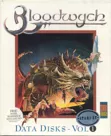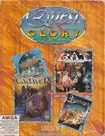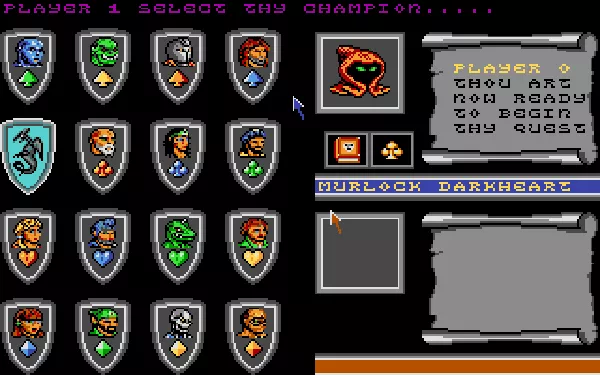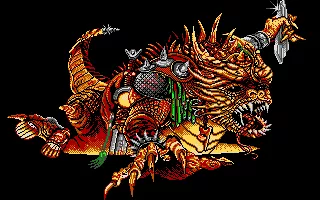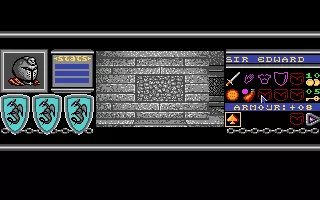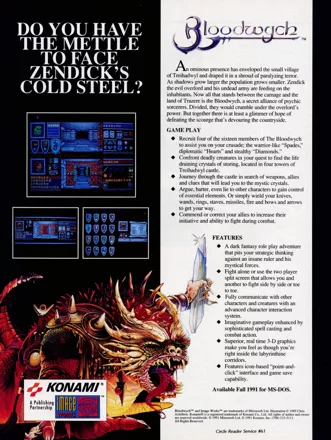Bloodwych
Description official descriptions
The land of Trazere was once ruled by the powerful and benevolent organization of mages known as Bloodwych. Governed by the Grand Dragon, the Bloodwych supervised over the balance in the land, protecting it from evil and driving it to prosperity. However, the second-in-command of Bloodwych, named Zendick, turned against his group, banished his opponents to the astral plane, and began working on a mad plan - summon the ultimate evil, the Lord of Entropy. The player controls the champion of Trazere, whose ultimate goal is to stop Zendick and restore peace in the country.
Bloodwych is an RPG in the style of Dungeon Master and Eye of the Beholder, being a 3D first-person maze-like game. This game's distinguishing feature is the two-player split screen support, allowing simultaneous playing on one computer.
Each player controls a party of four characters. The four basic classes are warrior, mage, adventurer, and thief; however, each class also has sub-classes, which are represented by four different colors. These colors come into play also when the characters learn and combine spells.
Groups +
Screenshots
Promos
Credits (DOS version)
| Programmed by |
|
| Cover illustration by | |
| Manual written and designed by |
|
Reviews
Critics
Average score: 78% (based on 15 ratings)
Players
Average score: 3.0 out of 5 (based on 31 ratings with 1 reviews)
The Good
Hmm, seems like a pretty big claim doesn't it? Well it certainly was one of the first multi-player dungeon crawls and where it differs from other multi-player games (even those of today) was that the 2 players had to play co-operatively. It was possible to kill the other player, in fact some of the spells made it quite a frequent occurrence, but if you killed the other player and they stayed killed then you could only get so far in the game.
I've made it sound like it was only a multi-player game and of course it had a single player game. In fact, I only ever played it as a single player, often with other people in the room watching and helping.
What was it like? Well, it's contemporaries were Dungeon Master and Eye Of The Beholder but, it differs from those in the same way they differ from each other. The graphics were small, under-stated yet well designed. The control system was perfect, employing the Dungeon Master style 3rd-hand to 'reach' into the pseudo-3D world for interaction. The sound was, admittedly, pretty bad. However, the gameplay...ah, well thats what makes it stand out.
The level construction was paramount for this game and it had to be. There's only so much time and effort that can be poured into a game and the ingredients for this game have definitely been ejected into a large urn labeled 'How it Plays!'. For a start, this game was meant for the masses, so, while it was an RPG it shied away from heavy statistics, hid the dice rolling in the CPU and negated the need to draw accurate maps.
The linear approach to level flow is shunned in most modern games but Bloodwych channeled you through levels and areas by giving you only a few immediate goals to accomplish at a time. For example, the way ahead would be barred by a locked door but the key for this locked door would not be placed 300 footsteps away where you'd forget what the key was for when you got there. The concept sounds limiting but the reality is compelling - it plays like reading a good book. Sid Meier always tried to create 'No decent point to turn off the game' and that is what Bloodwych also created. It was a case of, 'ah, I finished this little bit but now there is this place that I need to go to', almost the perfect interaction of a series of majestic set pieces.
The whole aura of the game spilled sophistication that is seldom matched even today. The limited graphics need only imagination to transform and this can be surprisingly liberating, after all, if you've created the creature or scenario then aren't you really there?
The Bad
Well, yes, the sound was bad. I guess it served its purpose and, like the 'functional' graphics, it allowed your imagination to fill in the gaps. This 'space' in games (as in life I suppose) is all too rare nowadays.
The Bottom Line
An RPG dungeon crawl for the masses. Sophisticated and compelling although perhaps lost on those who haven't grown up with it.
Atari ST · by Matt Styles (4) · 2005
Trivia
Remake
The developers of Bloodwych (Pete James and Anthony Taglione) later made a remake of their game, called Hexx: Heresy of the Wizard. The selectable characters are even the same for both games.
The game is set in the same universe as The Four Crystals of Trazere, which was also developed by the same programmers.
The 8-bit conversions
The 8-bit conversions of the game were written by Philip Taglione, younger brother of Anthony Taglione who created and designed Bloodwych. Z80 version was created first, running on Spectrum 48k and Amstrad CPC. Philip managed to squeeze the most of the game's essence into meagre amounts of available memory. The Spectrum version was crammed into the system - just 7 BYTES of memory was left on the largest levels. When Z80 version was finished, Commodore 64 version materialised where Anthony helped his brother with coding. Nevertheless some of the games features had to be sacrificed for 8-bit conversions. * Spectrum version had to employ a monochromatic 3D dungeon, which meant some of the objects left lying on dungeon floors were difficult to spot * most of the communications system was cut - talking was only allowed when the player encountered a shopkeeper. * there were no signs on the walls, so the only way the player knew he was at the shop was because the shopkeeper didn't attack the party * stone staircases known from Atari ST and Amiga versions were changed to ladders * there were no shelves that adorned the walls
DOS conversion
Walking Circles software house was responsible for DOS conversion of the game. It was based on 68000-source code and was released in 1991 by Konami. As the only version it featured in-game music written by David Whittaker.
Amstrad GX400 version
Based on Amstrad CPC version Philip Taglione procured a cartridge version of the game for Amstrad GX400. Instead of "save game" functionality it contained a pass-code generator, which created a long code consisting of numbers and letters. The codes were presented at the end of each dungeon level and "remembered" the items and general stats of the adventurers. On the contrary to 8-bit versions full communications system was implemented with improved cursor and animated Bloodwych logo on the title screen. No matter how advanced the development was, Mirrorsoft canceled the project mostly due to poor sales of the GX400 consoles. Pretty soon the publishing house was also closed.
Awards
- ST Format
- January 1990 (Issue #06) - Included in the list 50 Games of the Year
- May 1990 (Issue #10) - Included in the list "ST Format's 30 Kick-Ass Classics"
- Amstrad CPC
- Adventure Game of the Year 1990 - French Computer Press
Analytics
Upgrade to MobyPro to view research rankings!
Related Sites +
-
Amiga Reviews - Bloodwych
A particularly glowing review of the game, from Scott Johnson, whose hit Hired Guns was greatly inspired by this game. -
The Un-Official Bloodwych Site
A fansite dedicated entirely to Bloodwych.
Identifiers +
Contribute
Are you familiar with this game? Help document and preserve this entry in video game history! If your contribution is approved, you will earn points and be credited as a contributor.
Contributors to this Entry
Game added by Fafnir.
Linux, Windows, Macintosh added by Plok. ZX Spectrum, Commodore 64 added by JRK. Atari ST, Amiga added by Martin Smith. Amstrad CPC added by Kabushi.
Additional contributors: Ye Olde Infocomme Shoppe, Martin Smith, Patrick Bregger, mailmanppa, karnak1, Jo ST.
Game added April 4, 2001. Last modified April 4, 2024.

